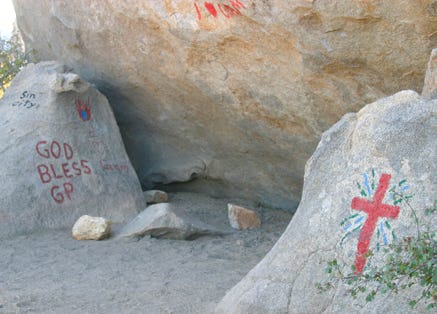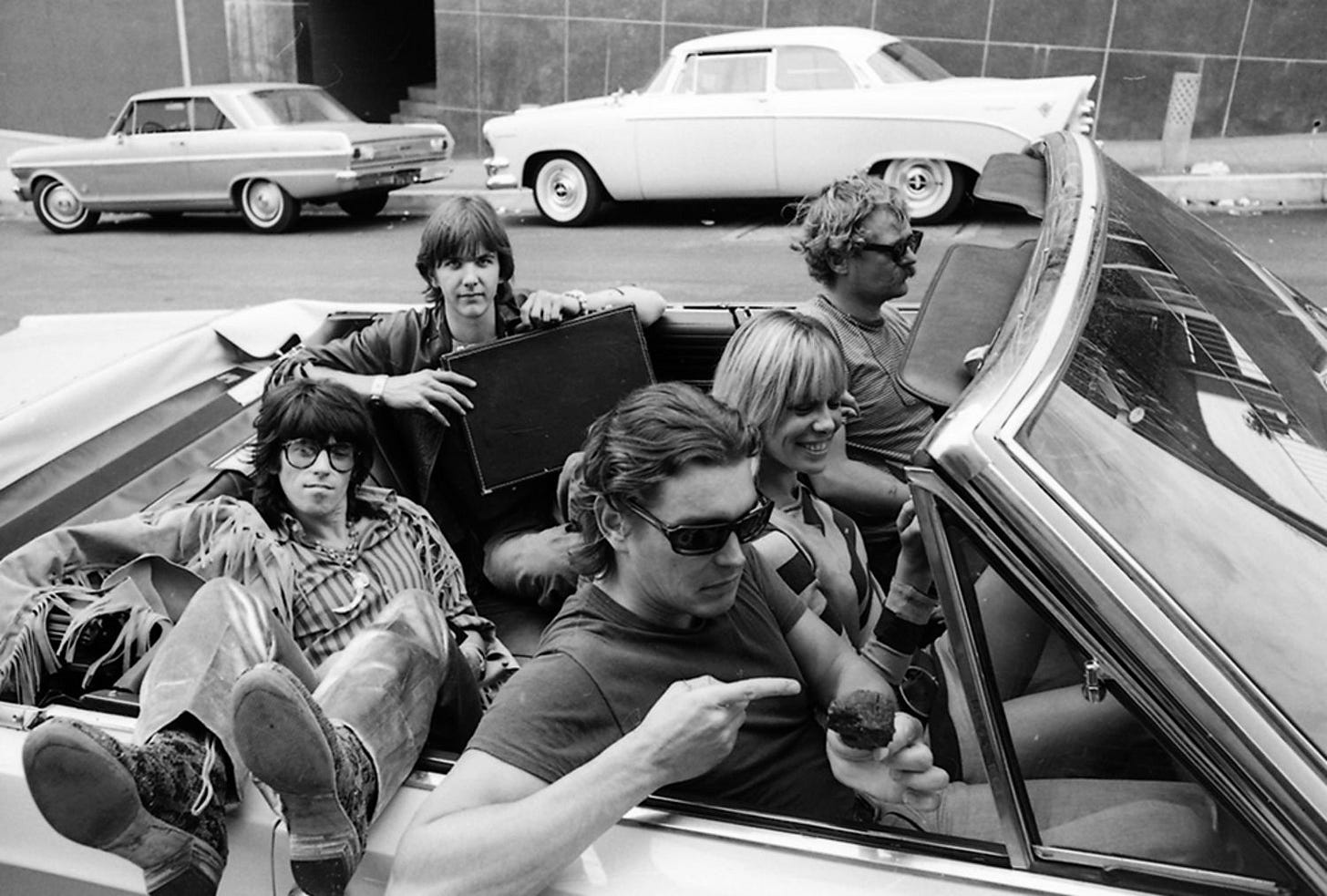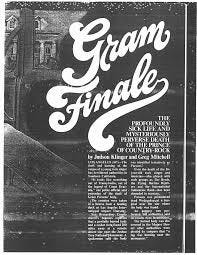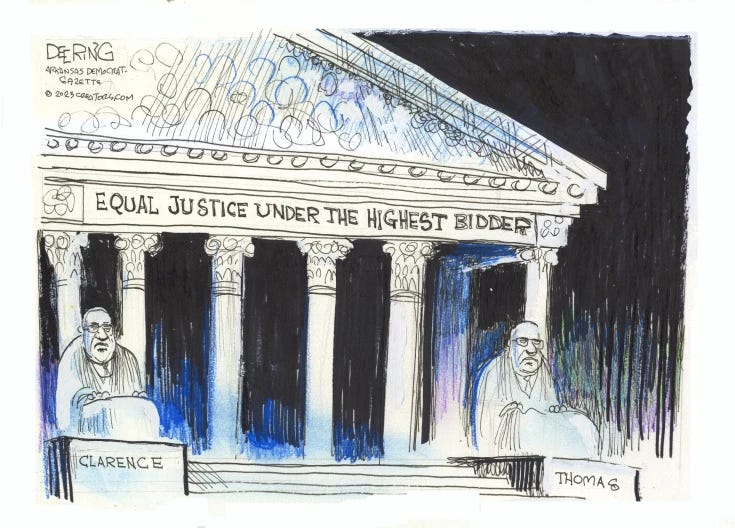Gram Theft Parsons
Revisiting my part in the epic 1976 article that first revealed truth about the country-rock legend's death (and cremation at Joshua Tree).
Greg Mitchell is the author of a dozen books and now writer/director of award-winning films, including this one coming to PBS stations in May. He was also a longtime editor of the legendary Crawdaddy.
Since Phil Kaufman is, somehow, a Facebook friend and he’s always announcing plans for leading another tour of a certain site out at Joshua Tree, the morbid death of Gram Parsons is rarely time out of mind. But a major L.A. Times piece on its “legacy” for Joshua Tree—from the motel room where he died, now a shrine, to the site near Cap Rock where Phil burned the body—reminded me that I have never posted a segment of my memoir-in-progress about helping to break the true story at Crawdaddy back in 1976. So here it is. And as I announced last night, check out your tab, if you have one, for the new Substack Notes, and you will find shorter takes all day—one might call them “subs” or “short stacks.” Enjoy, then please subscribe (now more reasons than ever), it’s still free. Below: Gram with Keith Richards, and Phil Kaufman at the wheel.
I’d been a huge Gram Parsons fan going back to the classic country album he inspired the Byrds to record, Sweetheart of the Rodeo, and then on to the Flying Burrito Brothers--and finally his two solo albums with Emmylou Harris. When I read, on that sad day in mid-September 1973, that he’d died suddenly at the age of 26 in California--yes, news still broke in the newspapers back then--I picked up a shoe and threw it across my living room on West End Avenue in Manhattan, cracking my telephone. My reaction to Jimi’s and Janis’s deaths weren’t half that angry.
Soon word filtered out that he’d likely ODed, then his body hijacked from a hearse at L.A. International Airport and taken to the desert, at Joshua Tree--and burned by his former manager, Phil Kaufman. This was the same Phil who earlier had produced an album by an aspiring rock star he met in prison after a marijuana bust, named Charles Manson. Police had actually labeled the latest Kaufman case “Gram Theft Parsons.” One cop was quoted by the AP: “It looks like something out of Transylvania, out of the legend of Count Dracula.” Authorities had been alerted by campers that “a log was burning near the monument.”
More than two years passed and not much more than that emerged. Emmylou wouldn’t talk about it at all. Theories abounded, ranging from an innocent heart attack to death-by-kinky-sex or suicide. Supposedly he had been revived with the old junkie method of an ice cube up the ass, but then suffered a relapse. Whatever. (Below, alt-take of “Return of the Grievous Angel” from final album, with Emmylou. His estate had to later pay some dough to a writer who claimed to have written, or partly written, the song.)
One day a freelancer out in California named Judson Klinger told us that he’d been interviewing people who knew Gram, including ex-Byrd Roger McGuinn, Eve Babitz, even a hesitant Emmylou, and wondered if we’d want a feature story. Of course, we said yes, provided he cracked the mystery of why Gram died and how the body ended up ablaze at Joshua Tree. Klinger turned in the piece a few weeks later and while extensive and more revealing than anything that had appeared on the case, it fell short of getting at the why and how of it all. So, as the biggest Gram fan in the office, I volunteered to pitch in and make some calls. Naturally, I became obsessed.
Within a couple of weeks I had gotten to the bottom of the story. I’d even chatted on the phone with Gram’s younger sister Avis, who sounded heartbreakingly like him with that same little catch in her voice. The upshot, as I wrote (some 8000 words worth) with Klinger under our dual byline: It turned out that GP’s life “was straight out of Tennessee—not Hank—Williams.” What we’d discovered:
Gram had written that he’d been “born in a little bitty tar hut” but in reality his grandfather had once owned about one-third of the Florida citrus fields. Grandma’s flower garden later became the entertainment complex Cypress Gardens.
Gram’s father, whose nickname was “Coon Dog,” became an alcoholic and blew his brains out with a shotgun when his son was about 12. His mother remarried a businessman named Bob Parsons (with Gram and Avis given his name). A few years later, mom died of malnutrition brought on my alcoholism. Some time after that, Bob Parsons had Avis committed to a mental institution to control her money—then he, too, died from drink.
Summarizing the family story we wrote: “Like his mother and stepfather, Gram became an alcoholic. Like his dad, he blew his brains out but he did it with a needle, not a gun. It might have been cleaner the other way.”
We then followed Gram’s trust-funded career, with plenty of quotes from former conspirators (Keith Richards was blamed for shooting him up with drugs and then stealing some of his country licks, maybe even “Wild Horses”) and many new details. Turns out Gram had a daughter from a first marriage few knew about and was separated from his second wife (also news to most). But what about his death and its grisly aftermath? We recounted and disputed some of the theories, then the aftermath:
Kaufman claimed he’d had a death pact with Gram—whoever died first would have his body burned by the survivor. Gram’s stepfather had wanted the body shipped back to New Orleans for legal/estate reasons. Phil managed to secure the casket at the airport by claiming the family had changed its mind and, since he was driving a hearse, had no trouble signing for it.
Kaufman and a friend were fined just $300 plus restitution for the burned casket. The body (a charred log) did get shipped to New Orleans for burial, after all that.
The owner of the motel, Frank Barbary, where Gram died and his son, Al, who found the body, finally went on the record about the fatal night. Al said, “His heart stopped, all right--‘cause he went into a coma.”
The sad, mundane truth: Gram had consumed a prodigious amount of booze, probably tequila, and shot up some morphine he had just scored at a local Swap Meet. Girls left him alone to get some Mexican food and found him near death, or dead, when they returned. One of them apparently thought jerking him off would revive him. Al Barbary gave him mouth-to-mouth but quit quickly, when he “just about got sick, there was so much poison in him.”
And there was this update: Frank Barbary said a couple of groups of women had come out to hotel to stay and requested the room where Gram died. Still a babe magnet. Even heartsick Emmylou herself would do this, with her daughter, a few years later.
(Below, another alt-take, this time for his most famous song, “Hickory Wind.”)
Given Gram’s cult status, we wouldn’t dream of putting him on the cover, reserving that for the ready-for-stardom Runaways (with Joan Jett). They’d just given their first full interview, stage-managed by wacky manager Kim Fowley, to our Charles M. Young. But the Gram story drew much wider notice afterward and inspired a couple of odd moments for me.
One afternoon at the office I picked up the phone and found a man claiming to be Phil Kaufman on the other end. Phil, who had gotten his start in the music biz as “executive nanny” to the the Rolling Stones around 1968--later calling himself “The Road Mangler”--didn’t sound too happy, and he was only five blocks away, under the arch at Washington Square Park. Would I meet him in a few minutes? Well, what the hell, what could happen in broad daylight with dozens of people nearby? A few minutes later: No Phil, and no explanation later. Well at least I had not been hijacked and thrown into the back of a hearse.
Another close call: A few months after our sensational story appeared, I was out in San Francisco to interview author Tom Robbins. He’d been something of a hermit until then so his publisher threw a little party for him—on a houseboat. Also invited was young Rodney Crowell, still in Emmylou’s band, I think, for he had written a song called (after the Robbins novel) “Even Cowgirls Get the Blues.” So I’m sitting at the bar and Rodney walks up to get a drink, bitching loudly (in mid-rant), “Emmy was so upset about that damn Crawdaddy article, if I find the guy who wrote it I will….” Let’s just say he did not close with “thank him.”
From opening spread in Crawdaddy, summer 1976:






I don't even remember that....but Cameron's mom did strike home as I used to his house in mid-afternoon and she would say, "Oh, he's not home from school yet."
Thanks for sharing about Gram. I liked his music and became somewhat obsessed after reading Ben Fong Torres’ biography, Hickory Wind. I spent my high school years down San Diego way and saw lots of concerts at the Sports Arena including a multi act show in ‘68 featuring Buffalo Springfield, the Byrds,Turtles, Box Tops and Linda Ronstadt with Stone Poneys among others. Although I didn’t know it at the time, it was one of Gram’s first
shows with the Byrds.